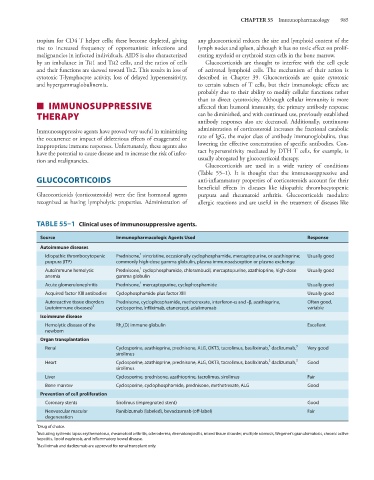Page 999 - Basic _ Clinical Pharmacology ( PDFDrive )
P. 999
CHAPTER 55 Immunopharmacology 985
tropism for CD4 T helper cells; these become depleted, giving any glucocorticoid reduces the size and lymphoid content of the
rise to increased frequency of opportunistic infections and lymph nodes and spleen, although it has no toxic effect on prolif-
malignancies in infected individuals. AIDS is also characterized erating myeloid or erythroid stem cells in the bone marrow.
by an imbalance in Th1 and Th2 cells, and the ratios of cells Glucocorticoids are thought to interfere with the cell cycle
and their functions are skewed toward Th2. This results in loss of of activated lymphoid cells. The mechanism of their action is
cytotoxic T-lymphocyte activity, loss of delayed hypersensitivity, described in Chapter 39. Glucocorticoids are quite cytotoxic
and hypergammaglobulinemia. to certain subsets of T cells, but their immunologic effects are
probably due to their ability to modify cellular functions rather
than to direct cytotoxicity. Although cellular immunity is more
■ IMMUNOSUPPRESSIVE affected than humoral immunity, the primary antibody response
THERAPY can be diminished, and with continued use, previously established
antibody responses also are decreased. Additionally, continuous
Immunosuppressive agents have proved very useful in minimizing administration of corticosteroid increases the fractional catabolic
the occurrence or impact of deleterious effects of exaggerated or rate of IgG, the major class of antibody immunoglobulins, thus
inappropriate immune responses. Unfortunately, these agents also lowering the effective concentration of specific antibodies. Con-
have the potential to cause disease and to increase the risk of infec- tact hypersensitivity mediated by DTH T cells, for example, is
tion and malignancies. usually abrogated by glucocorticoid therapy.
Glucocorticoids are used in a wide variety of conditions
(Table 55–1). It is thought that the immunosuppressive and
GLUCOCORTICOIDS anti-inflammatory properties of corticosteroids account for their
beneficial effects in diseases like idiopathic thrombocytopenic
Glucocorticoids (corticosteroids) were the first hormonal agents purpura and rheumatoid arthritis. Glucocorticoids modulate
recognized as having lympholytic properties. Administration of allergic reactions and are useful in the treatment of diseases like
TABLE 55–1 Clinical uses of immunosuppressive agents.
Source Immunopharmacologic Agents Used Response
Autoimmune diseases
1
Idiopathic thrombocytopenic Prednisone, vincristine, occasionally cyclophosphamide, mercaptopurine, or azathioprine; Usually good
purpura (ITP) commonly high-dose gamma globulin, plasma immunoadsorption or plasma exchange
1
Autoimmune hemolytic Prednisone, cyclophosphamide, chlorambucil, mercaptopurine, azathioprine, high-dose Usually good
anemia gamma globulin
1
Acute glomerulonephritis Prednisone, mercaptopurine, cyclophosphamide Usually good
Acquired factor XIII antibodies Cyclophosphamide plus factor XIII Usually good
Autoreactive tissue disorders Prednisone, cyclophosphamide, methotrexate, interferon-α and -β, azathioprine, Often good,
(autoimmune diseases) 2 cyclosporine, infliximab, etanercept, adalimumab variable
Isoimmune disease
Hemolytic disease of the Rh o (D) immune globulin Excellent
newborn
Organ transplantation
3
3
Renal Cyclosporine, azathioprine, prednisone, ALG, OKT3, tacrolimus, basiliximab, daclizumab, Very good
sirolimus
3
3
Heart Cyclosporine, azathioprine, prednisone, ALG, OKT3, tacrolimus, basiliximab, daclizumab, Good
sirolimus
Liver Cyclosporine, prednisone, azathioprine, tacrolimus, sirolimus Fair
Bone marrow Cyclosporine, cyclophosphamide, prednisone, methotrexate, ALG Good
Prevention of cell proliferation
Coronary stents Sirolimus (impregnated stent) Good
Neovascular macular Ranibizumab (labeled), bevacizumab (off-label) Fair
degeneration
1
Drug of choice.
2
Including systemic lupus erythematosus, rheumatoid arthritis, scleroderma, dermatomyositis, mixed tissue disorder, multiple sclerosis, Wegener’s granulomatosis, chronic active
hepatitis, lipoid nephrosis, and inflammatory bowel disease.
3
Basiliximab and daclizumab are approved for renal transplant only.

